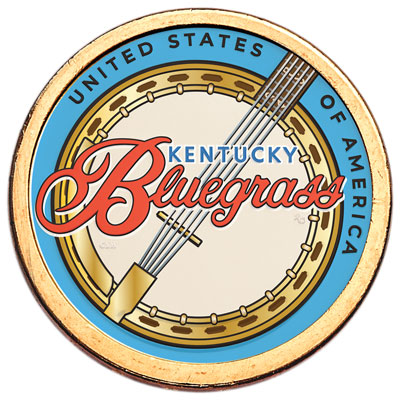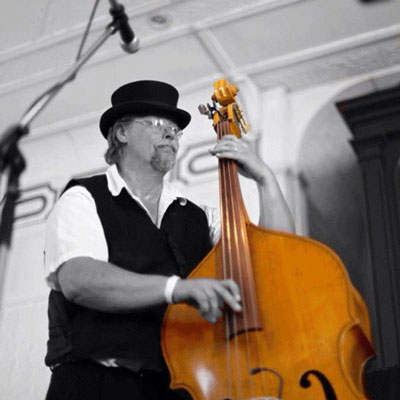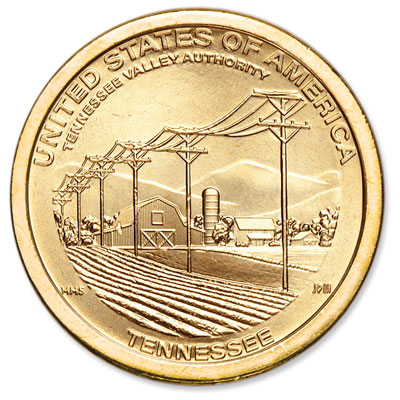Celebrating Bluegrass & the Banjo!

American creation takes a lot of forms. The U.S. Mint is proving that with each new Innovation dollar it rolls off its coin presses for the series launched in 2018. The one that struck a chord like few others before it was born in the Kentucky hills. With a reverse design featuring the round head of a banjo, it celebrates the uniquely melded-in-America musical genre known as bluegrass.
Where to find the Choice Proof ‘banjo’ dollar
The Kentucky Innovation dollar was so anticipated, the mint sold out of 25-coin rolls and 100-coin bags well before the June 28, 2022 release date. Illustrator Christina Hess of the mint’s Artistic Infusion Program created the design. On her website, she noted, “After researching the origins of bluegrass music and the variety of instruments I landed on representing the banjo along with a rhythmic font for this particular design.”
You could say this musical form was a progression of styles that came ashore in the 1600s. Folk songs and ballads brought to America from both the British Isles and the African diaspora are its heartbeat. The fiddle is the former’s instrument. The latter’s, the lute gourd. It evolved in design and name to the bright, twangy sound of what we today call a banjo.

Assigning bluegrass as Kentucky’s innovation for this coin series also was a progression, thanks to native son and singer-songwriter Bill Monroe. Born early in the 20th century, he grew up playing music with his siblings on the family’s hardscrabble farm on Jerusalem Ridge near Rosine.
“There was three of us brothers to start with…they was older than I was, and one of ‘em – Birch – wanted to play the fiddle. Charlie loved the guitar…So I got the mandolin…,” Monroe said in a transcribed interview published in 2000.
The Ballad of Jed Clampett
Monroe’s talent was shaped by the Scottish and English ballads sung by his mother, Malissa V. Monroe; the hoedown fiddling of his uncle, Pendleton Vandiver, who taught him the importance of keeping time, and blues player and friend Arnold Shultz, a popular black musician credited with developing a thumb-style method of picking.

In 1938, Monroe, a tenor, formed a backing band he called the Blue Grass Boys. It was a nod to the nutritious pasture forage associated with his home state’s thoroughbred racing horses. But quickly it became the one word – bluegrass – attached to often wistful lyrics, tight harmonies and fast tempos that were getting Monroe national attention. In 1946, he added banjo player Earl Scruggs. Scruggs’s picking gained fame in popular culture when he performed the theme song for the ‘60s TV sitcom, The Beverly Hillbillies.
“There’s always been a bluegrass community around here,” said Chris, Littleton Coin’s network administrator, about the genre’s appeal. “It just hasn’t always been well-known or visible to the general public.”
A bass player in a number of regional bluegrass bands throughout northern New England, Chris added, “About every twenty years or so it gets ‘rediscovered’, and is popular again.”
Circling Back to Folk Culture
Bluegrass isn’t the only musical genre associated with Kentucky. During the mint’s wildly successful Statehood quarters series, it released a reverse design in 2001 that featured the estate house in Bardstown said to have inspired composer Stephen Foster to write My Old Kentucky Home in 1852. The self-taught Foster, who performed in minstrel shows as a youngster, melded Irish melodies, German songs and Italian operas in his compositions, according to the Library of Congress.
After My Old Kentucky Home became popular, the state bought Federal Hill and dedicated it as a historic site. In 1923, the mansion was renamed after the song. Foster’s sentimental ballad became the state song of Kentucky in 1928.
Do You Have These Other Kentucky Coins?
Kentucky became the 15th state to join the Union in 1792 when it split from neighboring Virginia. But thanks to the Appalachian Mountains, it remains connected as seen in Littleton Coin’s Showpak for the 2016 Cumberland Gap National Historical Park quarter. The park’s welcome center is located in Middlesboro, near where you can see the natural break in the range between the two states.
South of Fort Knox is the LaRue County seat of Hodgenville. It’s more famous as the birthplace of Abraham Lincoln, illustrated in this 2009 gold-plated cent.

Last but by no means least, Kentucky is represented in Tennessee’s Innovation dollar, which pays tribute to rural electrification. Not far from where the Cumberland River feeds into the Tennessee River, and 22 miles upriver from Paducah where the Tennessee then empties into the Ohio River, the federal government built the colossal 184-mile-long Kentucky Hydro-electric Dam.
As the longest dam in the Tennessee Valley Authority’s network, the reservoir behind it provides water storage that helps reduce flood crests on the Ohio and Mississippi Rivers. Filling the Kentucky Reservoir in 1945, also helped open the seven-state, 652-mile Tennessee River to year-round navigation. Most importantly, the hydro-electric dam has a net dependable generating capability of 184 megawatts.
Do you own any of these coins relating to Kentucky’s music and natural history? Tell us in the comments section below!
Sources:
Gibbs, William T. “Enrollments lead Kentucky American Innovation dollar sales.” Coin World, July 2, 2022. https://www.coinworld.com/news/us-coins/enrollments-lead-kentucky-american-innovation-dollar-sales
Ratzlaff, Eli. “Black History of the Banjo.” Blog. The Front Porch. February 14, 2022 https://frontporchcville.org/black-history-of-the-banjo/
Bluegrass Heritage Foundation. “A Brief History of Bluegrass Music.” Accessed October 28, 2022. https://bluegrassheritage.org/history-of-bluegrass-music/
Monroe, B. “Bill Monroe: King of BlueGrass Music.” By Doug Benson. The Bill Monroe Reader. University of Illinois Press. 2006
Byrne Jr., Dave. “Bill Monroe | Rosine, KY| Bluegrass Trails.” Accessed November 3, 2022. https://mygrassisblue.com/rosine-kentucky/
Library of Congress. “Stephen Collins Foster, 1826-1864.” Accessed November 7, 2022. https://www.loc.gov/item/ihas.200035701/
Tennessee Valley Authority. “Navigation on the Tennessee River.” Accessed October 21, 2022. https://www.tva.com/environment/managing-the-river/navigation-on-the-tennessee-river



